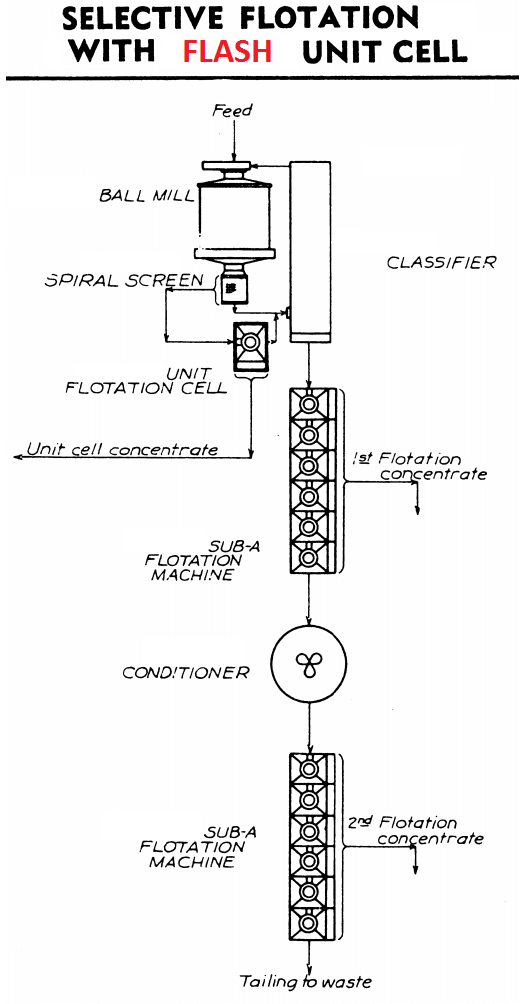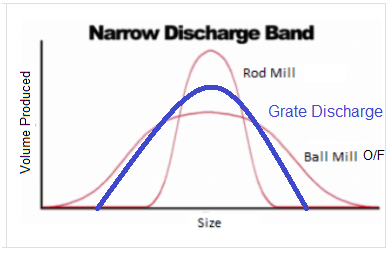- To participate in the 911Metallurgist Forums, be sure to JOIN & LOGIN
- Use Add New Topic to ask a New Question/Discussion about Grinding.
- OR Select a Topic that Interests you.
- Use Add Reply = to Reply/Participate in a Topic/Discussion (most frequent).
Using Add Reply allows you to Attach Images or PDF files and provide a more complete input. - Use Add Comment = to comment on someone else’s Reply in an already active Topic/Discussion.
Rod Mill or Grate Discharge Ball Mill ? (6 replies and 1 comment)
Rod Mill VS Grate Discharge Ball Mill? What an excellent question!
I find both are great under appreciated technology. The Cominco Polaris mine had a coarse Pb flotation embedded into its grate discharge ball mill grinding circuit.
It looked like this below and worked wonderful. The ball mill had for feed the short head cone crusher discharge with up to 40 mm rocks. We had a 90 mm grinding ball.
We simply had hydrocyclones for classification. Your spiral setup is better. We found the source of over-grinding was the cyclone's inability to push the coarse out the overflow more than the mill itself over-grinding.
The setup below allowed us to extract the coarse Pb at 500-800 um (in the flash float) while providing a 200 um grind for the rest/general Lead & Zinc flotation.
The rod mill will limit you to around 800 um

I speculate with the blue line in graph below. The grate ball mill is likely halfway in between an overflow ball mill and a rod mill.
As much as I like rod mills, in your situation, I would go with a ball mill (for ease of operation).
Be sure to have good classifier efficiency and you are in the clear.

This choice obviously, is just of matter taste to me. I have no supporting data.
We used a rod mill in our spiral circuit and it worked fine. As dfelsher mentioned rod mill prevents over grinding and is recommended for the production of a narrowly-sized mill product. You can also try charging rods through outlet without shutting down.
I asked a friend from the mill manufacturing and mill lining industry and he had this to say:
"I would most likely favour a rod mill for a case like this. The BWI is apparently quite low (as it should be for a blend of limestone and galena) and the tonnage is also low at 15 TPH, so we are not talking about a very big mill. If they would go with the lowest possible L/D aspect ratio requirement for rod milling (~1.4:1) they could keep the length of the rods and therefore their mass to a minimum for handling purposes. This way they could avoid the need for a classification circuit, and liner maintenance would be a lot simpler. It’s not that easy to install a grate discharge end into a really small mill, in my experience.
Even if you manufacture all of the components on a small scale, you still have to find a really tiny person to install them, and they better not be claustrophobic."
In preliminary mill sizing, you may find this useful:
https://www.911metallurgist.com/blog/rod-mill-design-calculations
https://www.911metallurgist.com/blog/calculate-ball-mill-grinding-capacity
Looks like 2 m X 3 m mill
As you mentioned, the ore is easily liberated and also the ore is not so hard and fragile in nature.
You can try High Pressure Grinding Roll (HPGR) to obtain -200+100 micron size range product which minimises the energy require and also the fines generation.
To produce a milled product at around 1mm top size the most efficient way to get the material milled with minimal fines is by using a three stage jaw crushing circuit with 1mm interstage screening between the crushers.
The first jaw is used to bring the ore down to around 25 - 35mm pieces, the second jaw takes the oversize from the screen and brings it down to 5mm, the third jaw takes the oversize from the second screen and is run choked.
Any oversize material from the third screen is recycled back to the third jaw.
The <1mm final product is a perfect feed for a gravity circuit, sliming is minimal and sulphide liberation is maximised.
The screens can be changed to give a < 0.6mm product if required due to liberation concerns but is usually not warranted.

Hi All,
we want to mill a relatively soft galena in limestone ore to prepare it for gravity concentration. Flotation is not possible at the site.
The ore is easily liberated, so a grind down to about p80 of 1mm is ok, to feed it to spirals and shaking tables. We did some test-work in the lab, concentrate grade and recovery are ok. Now we want to upscale it to a small plant with 15tph. Feed size can be varied between 10 and 25mm.
In order to reduce Pb losses in the fine range we need to use a milling circuit which does not produce too much fines (<100µm). After the mill there would be a screen with 1mm opening, fines to spirals, coarse back to the mill.
I used rod mills for such a coarse grind, but the handling of the rods is not as easy as if you use balls. So the question came up what a grate discharge ball mill would do here. I never used one. There are some comparisons available with normal (overflow) ball mills, but I could not find a comparison to a rod mill.
What are your experiences?
Best regards
Hermann